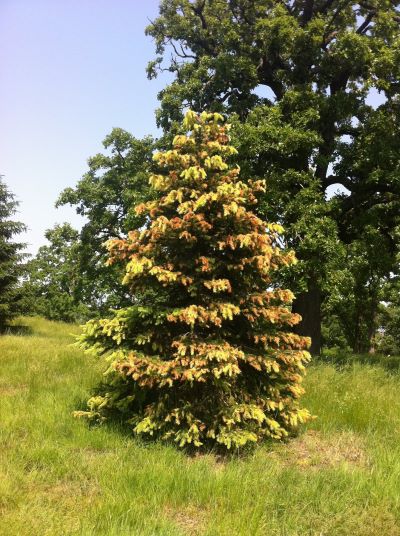Kill weeds, not trees
By Dr. Quincy Law, Assistant Professor of Turfgrass Science, Iowa State University, [email protected]
Introduction

Aminocyclopyrachlor injury on Norway spruce. Iowa State University Turfgrass photo.
Herbicide selectivity informs applicators of both the spectrum of weed control and the species it can be safely applied to. Applicators should select herbicides that are effective on target weed species and safe on desired species. However, there is often a fine line between herbicide efficacy and off-target injury to desired plants such as trees.
Most of the noxious weeds in both Montana and Iowa are broadleaf species, also known as dicots. Conversely, roadsides, rangelands, and other turf areas are largely comprised of grasses (i.e., monocots). The differences between these two types of plants enables the selective control of broadleaf weeds in perennial grass systems. However, it is important to remember that other plants in the landscape, trees in this example, are also dicots and thus may be susceptible to off-target herbicide injury.
Information on the Label
It is paramount to read and follow pesticide labels. Herbicide labels can inform applicators of susceptible species, even warning of potential injury. For example, leafy spurge is a troublesome weed species that is difficult to control. Two effective herbicides for leafy spurge control are aminocyclopyrachlor (Method 240SL) and picloram (Tordon 22K). Labels for both products listed contain verbiage regarding potential tree injury.
The simple fact that a product is labeled for use in forests does not mean it is safe on all trees. For example, triclopyr (Garlon 3A) is labeled for use in forests and aquatic sites. The herbicide controls problematic weeds including Canada thistle, purple loosestrife, and saltcedar. However, triclopyr also controls common tree species such as ash, aspen, cottonwood, elm, oak, and pine. Applicators must understand the spectrum of plants controlled or injured by the herbicides they are using to avoid off-target injury.
Effects of Herbicide Formulation
Herbicide formulation can also play a role in off-target injury. Synthetic auxin herbicides are commonly formulated as amines and esters. Amine formulations are generally less volatile than esters and are safer to use around sensitive plants. Whereas ester formulations have a higher vapor pressure and volatilization potential. Research by Schleicher and colleagues at Purdue University demonstrated that in cooler spring months, 2,4-D ester can provide better broadleaf weed control than amine formulations due to the ability to penetrate the waxy cuticle more readily. As temperatures warm, amines work as well as esters, with less risk of volatility.
Application Methods
Directed sprays and selective equipment are another means to enhance tree safety and reduce the chance of off-target injury. For example, glyphosate (Rodeo), a nonselective herbicide, is labeled for use in forestry conifer and hardwood sites when applied as a directed spray or with selective equipment. In this case, the means of herbicide application, not the herbicide itself, confers safety to desired trees. Given that application technology is rapidly evolving, applicators should utilize equipment and techniques that reduce the risk of tree injury.
Weather Conditions
Lastly, herbicides should not be applied when a temperature inversion exists. During a temperature inversion, small droplets, such as herbicide droplets, are “trapped” below the air inversion layer and can move significant distances from where they were applied. While some herbicide labels have specific guidelines regarding temperature inversions, applicators should understand what an inversion is and avoid applying any products in one.
Further Information
For more information about this month's weed post, contact Associate Extension Specialist Noelle Orloff. Past posts are available in the Monthly Weed Post Directory.
This weed post is also available as a printable PDF (205 KB).
